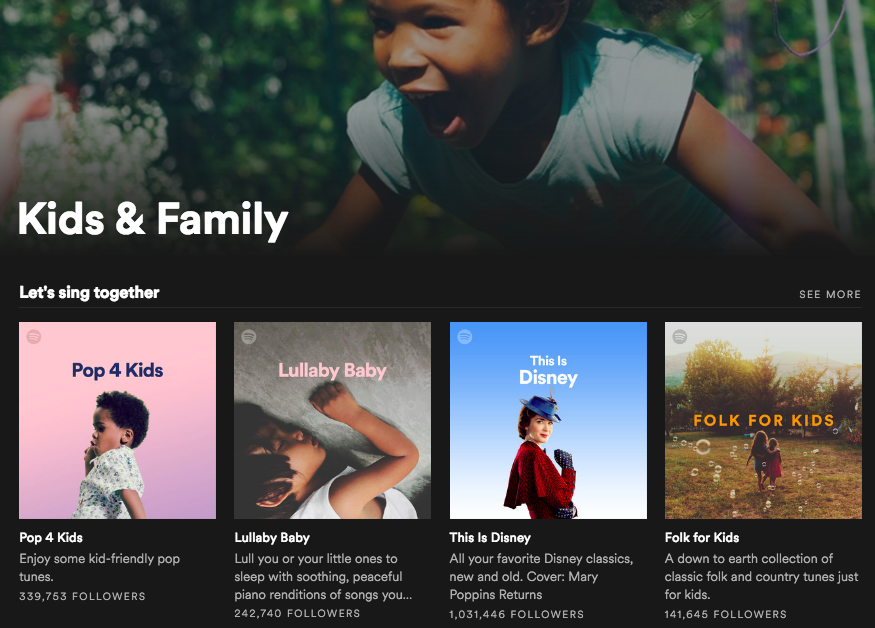Spotify
Spotify is a leading music streaming service that aims to unlock the potential of human creativity by giving artists the opportunity to live off of their art and fans the opportunity to enjoy and be inspired by it.
As a user research intern, I worked with the Growth Opportunities team in New York City that is dedicated to creating products for new markets and audiences. During my summer, I worked on two main projects:
1) Foundational Research: Diary Study + Interviews on Family and Kids’ Listening
Why did we embark on this research?
Upon seeing a market opportunity for developing content and products for family and kids’ listening, our Product Insights team (data scientists + user researchers) decided to undertake foundational research for what Spotify’s future with this listening audience could be.
The hub of kids music and playlists on Spotify’s desktop app
What was my role in the research?
I worked closely with a senior user researcher to create, conduct, and analyze a 6-week diary study around how families listen to music while working collaboratively with a team of product managers, designers, and engineers. Towards the end of the diary study, we interviewed 10 participants in their homes to probe for deeper insights on participants’ habits and perspectives on how they listen to music.
I owned several parts of the research, including:
An Interview Guide for In-Home Visits
Facilitation of diary study for 30 participants (half of our total pool)
In-home interviews for 8 participants
I also compiled and presented analysis of the research, including:
A brief for the marketing team on branding and content recommendations for kids as a listening audience
An insights and recommendations deck for Product Insights on how household dynamics influence music choices and habits within a family
Why did we choose these methods?
We chose this combination of methods (diary study + in-home interviews) to achieve a complete picture of our participants, where we could see their concrete habits and choices over time through the diary study, as well as grasp deeper and unseen contexts through our in-person interviews.
2) Evaluative Research: Usability Testing on Mobile Web Player
Why did we embark on this research?
Previously, when listeners that didn’t have Spotify as a mobile app received a link to a Spotify song, they wouldn’t be able to play the song without installing the app. To improve new user interest and retention, our team decided to revamp the mobile web player to allow these listeners to have a taste of what Spotify offers.
What was my role in the research?
I facilitated and concluded findings from usability testing for the second version of this prototype. For this project, I recruited and interviewed 6 participants for one-hour interviews and testing on Android phones. Then, I analyzed video and written transcripts to compile a deck for a cross-functional group of designers, engineers, and product managers on design and usability recommendations to consider moving forward.
Why did we choose these methods?
Our team chose usability testing as a method to achieve quick and durable conclusions on tweaked design elements of the product. From this project, I also learned the importance of communicating and advocating for research in a group that had little previous collaboration with researchers.
If you'd like to see samples of my work from this internship, contact me!
